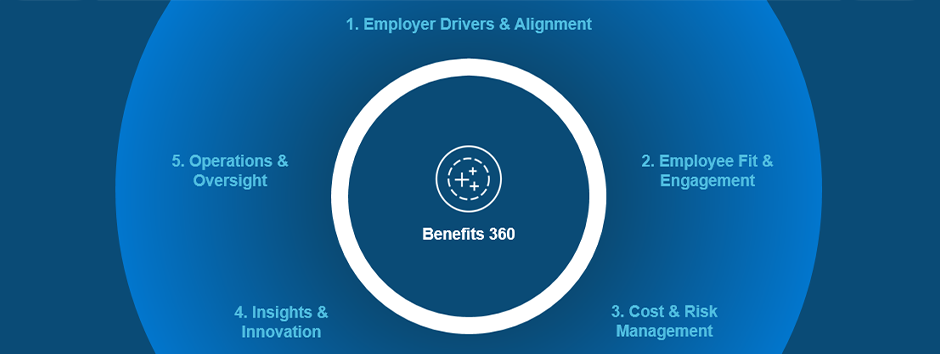Rebalancing global benefits now for a post-COVID-19 world
Multinational companies should start fundamentally reviewing their global benefits strategies now, to meet the future needs of their business and their employees.
As the economic effects of COVID-19 linger and even intensify worldwide, multinationals face a difficult challenge ahead: how to find the right balance in their benefit programs to meet the changing needs of their employees and their business globally. How will companies manage their benefits going forward?
Multinationals have had to react quickly with changes to health plans, leave policies and other remote working programs to keep their businesses going through the crisis, and support the immediate health and wellbeing of their employees globally. However, many of these were temporary solutions. The current mix of pre-COVID benefits and recent changes are probably not sustainable, or will not deliver what either employers or employees need in the post-COVID world. Most existing plans were designed for the past, not the future.
Admittedly, the future remains highly uncertain and most global businesses are still managing through the crisis. But smart organizations are also starting to plan ahead and revisit their strategies to secure the future success of their business after the pandemic—and the talent proposition needed to get there. It’s not about competitive advantage—it’s about survival.
Moreover, COVID-19 has been a massive shock—literally all over the world. It is presenting unprecedented challenges to the global economy, global health and wellbeing, social interaction, and the future of the workplace everywhere. This has caused misalignments of current global benefits programs, versus what employers want, employees value, and the market demands. There is too much cost and too much at stake. Many global employers will need to go back to the drawing board to reassess what plans are affordable, appreciated, deliverable, sustainable, and necessary. But let’s acknowledge how difficult getting the right benefits balance truly is. No company ever gets it perfectly right, even in “normal” times. More change is likely on the way. Cost and resource pressures are already significant for most organizations, and may get worse. Hard choices almost certainly lie just ahead.
Given all of this, plus the heightened importance of benefits in the employee value proposition and the significant cost and resources needed to deliver those benefits across the world, it’s critical for multinationals to start taking action now—to fundamentally review and realign their global benefits to the future needs of their business and their talent; and, to develop a model to effectively govern and evolve their benefit programs over time.
It’s a challenging task, yet eminently doable with a structured approach.

Where do we start? Take a “360-degree” view
Multinationals need to examine their current situation closely in order to drive the most effective and sustainable benefits programs for their business now and beyond COVID-19. We recommend breaking down the analysis into five areas of focus, so that companies look at their benefits from all critical angles. This helps clarify what benefits are most important, and which ones could be restructured. The process is aimed at analyzing the current state of the company, what the priorities and opportunities are, and what are some of the challenges or barriers getting in the way of progress.
Companies will have varying emphasis on the different angles, depending on their own unique situation—such as industry, size, and locations. Forward-looking multinational companies are looking at these five areas, asking key questions of the various angles to their programs:
- Employer drivers and alignment. Do our programs support our current and future business priorities and goals? Do they align with what we say and do as a business? This requires a critical look at the range of benefits offered—how do they fit with the company’s culture and purpose, and key organizational priorities such as employee well-being, inclusion and diversity, social responsibility, etc.
- Employee fit and engagement. Do we understand which elements of our benefits program employees truly value, and how to connect with them? Do our employees understand and appreciate what we offer? Here, examine demographic trends, and look at participant feedback with diagnostic tools such as surveys and focus groups. There can often be a “benefits value gap” between what a company spends on benefits and the value attached to those benefits by employees. Critical here is how effectively a benefits package is communicated to employees, especially in a post-COVID (virtual) world. Taking a more modern, consumer-centric and multi-faceted approach can help—tailored to what works best in local markets.
- Cost and risk management. Are we optimizing what we spend and our risk/reward objectives? Are our programs sustainable? Look at strategies on funding, investment, and insurance. Assess if and how cost sharing can help alleviate pain points, drive the right engagement from members, and better focus your benefit spend. Examine operating costs—leveraging the scale of your business, and in the market—to drive efficiency. Make this an ongoing effort by establishing appropriate dashboards.
- Insights and innovation. Do we really understand the “DNA” of our plans, and our key risks and opportunities? Do we adapt effectively and proactively? Ensure your plan inventory is up to date and usable (all too often it can be neither). Understand market competitiveness and trends, but also participation, utilization and cost trends. Look within and outside your industry to understand best practices to find inspiration to truly differentiate your benefits proposition—which will have most impact on your business and talent.
- Operations and oversight. Do we optimize our internal and external resources, administer plans efficiently, and make good timely decisions? Do we have the right balance of centralization versus local control, and on priority versus non-priority decisions? Assess the current operating model for global benefits against your new priorities, including the roles and skills of your team, any committees/boards, policies and protocols, security and systems, and compliance requirements. It’s likely a new operating model is required to meet the future needs of the business and employees.
Only by taking a 360-degree view will multinationals be able to sustainably design, deliver, and continually evolve their benefit plans to effectively support their future business and talent needs around the world. With the huge pressure on businesses and resources, the margin for error is small, and the risks of getting benefits wrong are more significant than ever.

Now is the time to start reviewing your global benefits strategy
COVID-19 has already forced the hand of many multinationals to make immediate, and likely temporary benefit changes all over the world to keep their businesses and employees going through the crisis. But now it’s time to look ahead—in fact it’s essential. Getting benefits right is a difficult task, but also an achievable one (even now), and it should rank high on a multinational’s list of priorities. It will ultimately make your company much more competitive, resilient, and successful—and your current and future employees more engaged and productive.
Contacts

John-Paul (JP) Augeri
Managing Director and Global EB Consulting Leader, Milliman
VIEW PROFILE
Email:
johnpaul.augeri@milliman.com
Tel: +1 347 541 1146
John-Paul (JP) Augeri
Managing Director and Global EB Consulting Leader, Milliman
A global human capital and risk management leader with wide-ranging technical and management experience.
JP joined Milliman to lead the Global Employee Benefits Consulting Practice, in partnership with MBWL. He has over twenty years’ experience helping multinational clients to design, deliver and manage programs globally across pensions, benefits and M&A. He specialises in solving complex global issues and delivering value and innovation to multinationals and their employees.
His expertise includes: global pensions and benefits; M&A; funding, investment, and derisking strategies; change management; total rewards and employee experience; global client management and business development.
He has also served as a board chair and senior advisor, as is a frequent external speaker who has helped lead several client roundtables.
JP is a Fellow of the Institute of Actuaries in the UK, and he has lived and worked in the US, UK, Germany, and Austria.

Mark Whatley
Principal and Consulting Actuary, Milliman
VIEW PROFILE
Email:
mark.whatley@milliman.com
Tel: +65 63272311
Mark Whatley
Principal and Consulting Actuary, Milliman
A highly driven employee benefits and retirement specialist internationally.
Mark provides independent and objective consulting advice on employee benefits to multinationals, local companies and government-linked organisations.
Mark has over 23 years of employee benefits, retirement and financial services experience gained in Asia, Europe and Africa.
Before joining Milliman, Mark headed Willis Towers Watson’s benefits consulting business in South East Asia for over seven years, with teams in five countries.
Mark is an expert on benefits and retirement practice in each market in the region, gained from single and multi-country project experience, including; benefits review and optimisation, retirement plan design, retirement actuarial valuation, retirement and benefits administration, flexible benefits design and pricing, benefits communication, pre-M&A benefits due diligence and post-M&A benefits harmonisation. He has also worked on several multi-streamed HR transformation projects across the region.
Contacts

John-Paul (JP) Augeri
Managing Director and Global EB Consulting Leader, Milliman
VIEW PROFILE
Email:
johnpaul.augeri@milliman.com
Tel: +1 347 541 1146
John-Paul (JP) Augeri
Managing Director and Global EB Consulting Leader, Milliman
A global human capital and risk management leader with wide-ranging technical and management experience.
JP joined Milliman to lead the Global Employee Benefits Consulting Practice, in partnership with MBWL. He has over twenty years’ experience helping multinational clients to design, deliver and manage programs globally across pensions, benefits and M&A. He specialises in solving complex global issues and delivering value and innovation to multinationals and their employees.
His expertise includes: global pensions and benefits; M&A; funding, investment, and derisking strategies; change management; total rewards and employee experience; global client management and business development.
He has also served as a board chair and senior advisor, as is a frequent external speaker who has helped lead several client roundtables.
JP is a Fellow of the Institute of Actuaries in the UK, and he has lived and worked in the US, UK, Germany, and Austria.

Mark Whatley
Principal and Consulting Actuary, Milliman
VIEW PROFILE
Email:
mark.whatley@milliman.com
Tel: +65 63272311
Mark Whatley
Principal and Consulting Actuary, Milliman
A highly driven employee benefits and retirement specialist internationally.
Mark provides independent and objective consulting advice on employee benefits to multinationals, local companies and government-linked organisations.
Mark has over 23 years of employee benefits, retirement and financial services experience gained in Asia, Europe and Africa.
Before joining Milliman, Mark headed Willis Towers Watson’s benefits consulting business in South East Asia for over seven years, with teams in five countries.
Mark is an expert on benefits and retirement practice in each market in the region, gained from single and multi-country project experience, including; benefits review and optimisation, retirement plan design, retirement actuarial valuation, retirement and benefits administration, flexible benefits design and pricing, benefits communication, pre-M&A benefits due diligence and post-M&A benefits harmonisation. He has also worked on several multi-streamed HR transformation projects across the region.